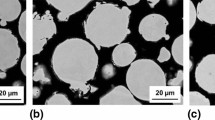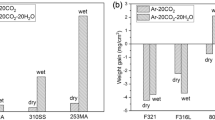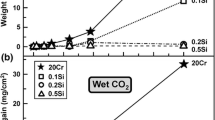Abstract
Essentially all alloys and coatings that are resistant to corrosion at high temperature require the formation of a protective (slowly-growing and adherent) oxide layer by a process known as selective oxidation. The fundamental understanding of this process has been developed over the years for exposure in pure oxygen or air. However, the atmospheres in most applications contain significant amounts of water vapor which can greatly modify the behavior of protective oxides. The development of oxy-fuel combustion systems in which fossil fuels are burned in a mixture of recirculated flue gas and oxygen, rather than in air, has caused renewed interest in the effects of water vapor and steam on alloy oxidation. The focus of this paper is on the ways the presence of water vapor can directly alter the selective oxidation process. The paper begins with a brief review of the fundamentals of selective oxidation followed by a description of recent experimental results regarding the effect of water vapor on the oxidation of a variety of chromia-forming alloys (Fe- and Ni-base) in the temperature range 600 to 700 °C. The atmospheres include air, air-H2O, Ar-H2O and Ar-H2O-O2. Then the behavior of alumina-forming alloys in H2O-containing atmospheres is briefly described. As hydrogen is produced during oxidation of alloys in H2O, it can be released back into the gas phase or injected into the metal (where it can diffuse through to the other side). Experiments in which hydrogen concentrations have been measured on both sides of thin specimens during oxidation by H2O on only one side are described. Finally, it is attempted to catalogue the various experimental observations under a few general principles.







Similar content being viewed by others
References
C. Wagner, Journal of the Electrochemical Society 99, 369 (1956).
R. A. Rapp, Acta Metallurgica 9, 730 (1961).
F. Gesmundo and F. Viani, Oxidation of Metals 25, 269 (1986).
C. Wagner, Zeitschrift für Elektrochemie 63, 772 (1959).
E. Essuman, G. H. Meier, J. Zurek, M. Hänsel, L. Singheiser, and W. J. Quadakkers, Scripta Materialia 57, 845 (2007).
M. H. B. Ani, T. Kodama, M. Ueda, K. Kawamura, and T. Maruyama, Material Transaction 50, 256 (2009).
G. H. Meier, K. Jung, N. Mu, N. M. Yanar, F. S. Pettit, J. Pirón Abellán, T. Olszewski, L. Nieto Hierro, W. J. Quadakkers, and G. R. Holcomb, Oxidation of Metals 74, 319 (2010).
N. Mu, K. Y. Jung, N. M. Yanar, G. H. Meier, F. S. Pettit, and G. R. Holcomb, Oxidation of Metals 78, 221 (2012).
M. Michalik, M. Hänsel, J. Żurek, L. Singheiser, and W. J. Quadakkers, Materials at High Temperatures 22, 213 (2005).
S. Henry, J. Mougin, Y. Wouters, J.-P. Petit, and A. Galerie, Materials at High Temperatures 17, 231 (2000).
N. K. Othman, J. Zhang, and D. J. Young, Oxidation of Metals 73, 337 (2010).
R. J. Ehlers, D. J. Young, E. J. Smaardijk, A. K. Tyagi, H. J. Penkalla, L. Singheiser, and W. J. Quadakkers, Corrosion Science 48, 3428 (2006).
M. P. Brady, Y. Yamamoto, M. L. Santella, and L. R. Walker, Oxidation of Metals 72, 311 (2009).
Acknowledgments
This work at University of Pittsburgh was performed in support of the National Energy Technology Laboratory’s ongoing research on Advanced Combustion under RES contract DE-FE0004000. The authors are most grateful to Prof. Shigenari Hayashi for help with the GD-OES measurements and Dr. M. P. Brady at ORNL for providing the AFA alloys.
Disclaimer
This report was prepared as an account of work sponsored by an agency of the United States Government. Neither the United States Government nor any agency thereof, nor any of their employees, makes any warranty, express or implied, or assumes any legal liability or responsibility for the accuracy, completeness, or usefulness of any information, apparatus, product, or process disclosed, or represents that its use would not infringe privately owned rights. Reference herein to any specific commercial product, process, or service by trade name, trademark, manufacturer, or otherwise does not necessarily constitute or imply its endorsement, recommendation, or favoring by the United States Government or any agency thereof. The views and opinions of authors expressed herein do not necessarily state or reflect those of the United States Government or any agency thereof.
Author information
Authors and Affiliations
Corresponding author
Rights and permissions
About this article
Cite this article
Mu, N., Jung, K., Yanar, N.M. et al. The Effects of Water Vapor and Hydrogen on the High-Temperature Oxidation of Alloys. Oxid Met 79, 461–472 (2013). https://doi.org/10.1007/s11085-012-9349-8
Received:
Published:
Issue Date:
DOI: https://doi.org/10.1007/s11085-012-9349-8




